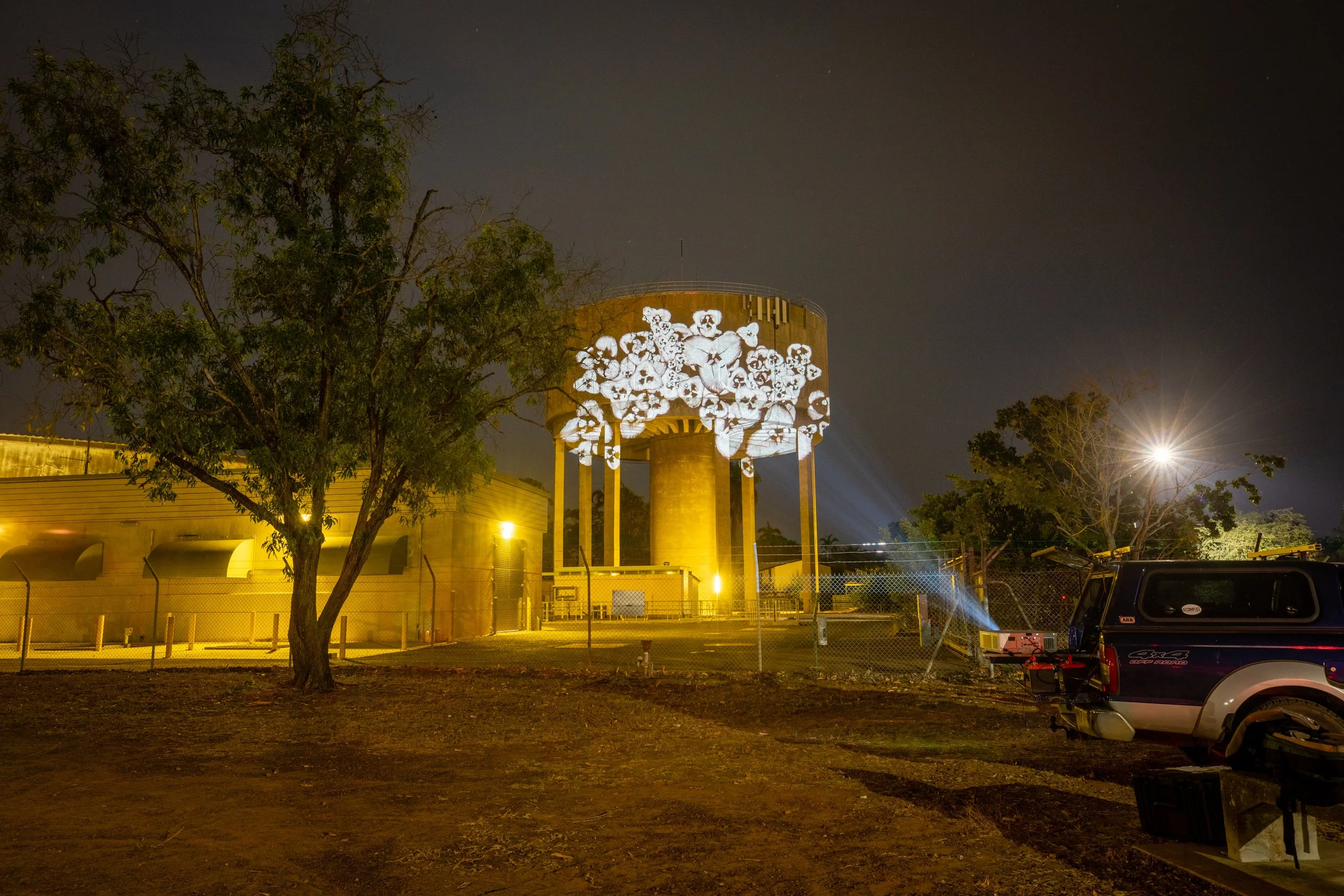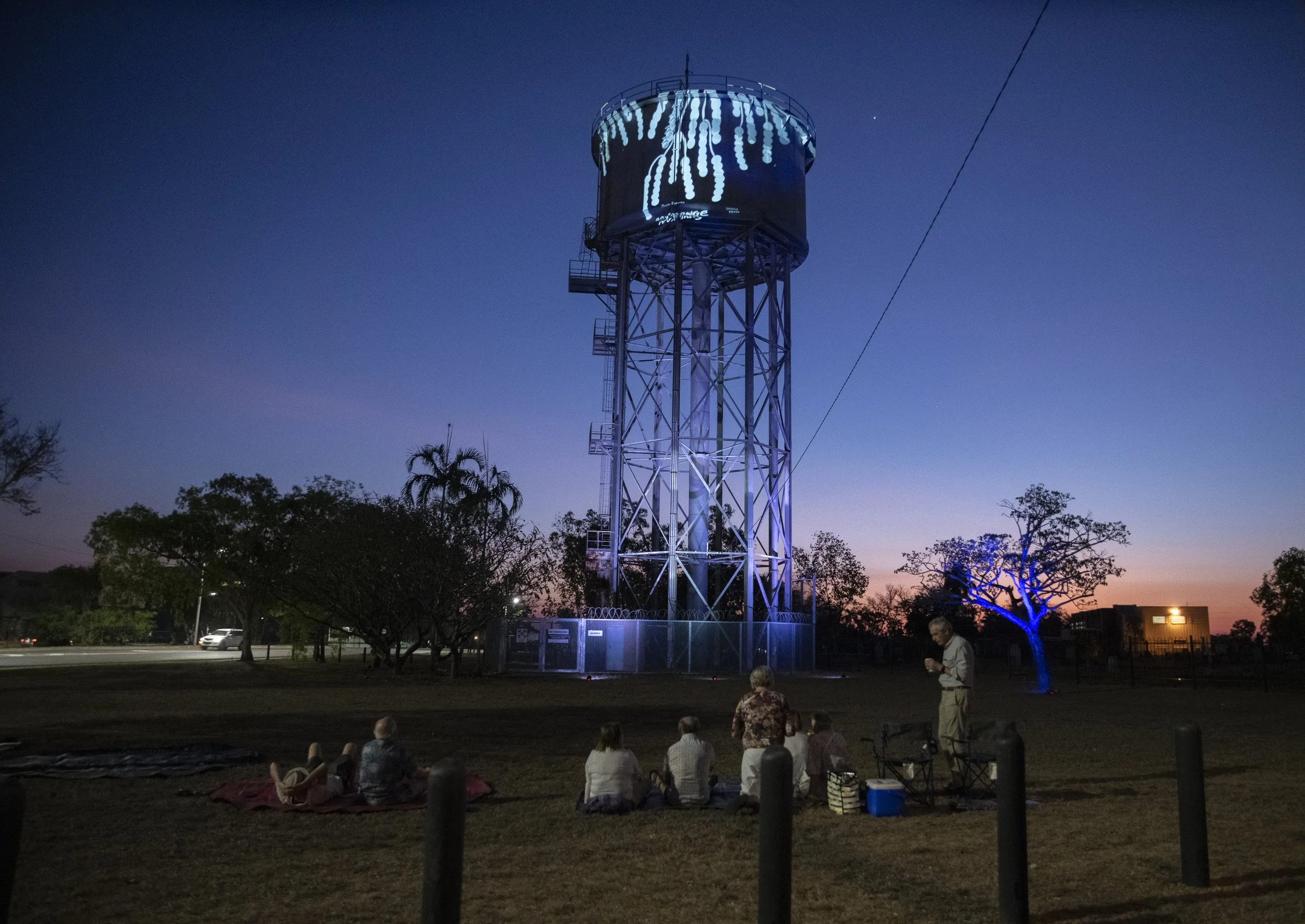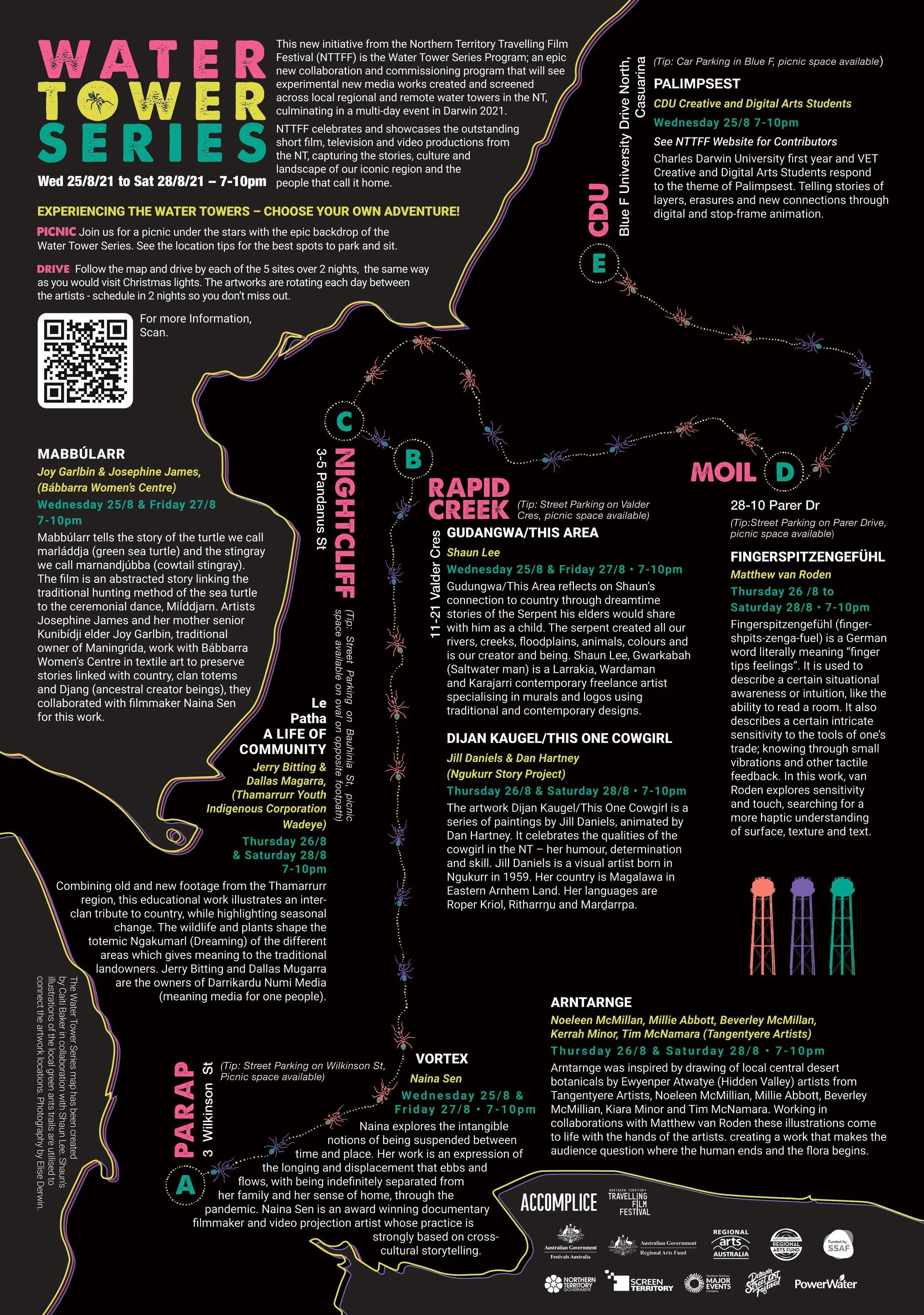Kinship with Water Towers where we explore creative practices that attune to the rhythms of human and beyond-human kinship. This space holds the artefacts and stories born from my ongoing relationship with the Moil Water Tower and its companions across the Northern Territory. These towering structures are more than infrastructure; they are collaborators, mentors, and relational beings that invite connection, imagination, and care.
Here, you’ll encounter artefacts from projects such as Botanicals, a new media piece blending local flora and Matty van Roden’s skin-dance projections, and the broader Water Tower Series, where towers across the Territory became co-creators with artists. Each artefact reflects the entangled relationships between place, community, and creative practice, revealing the towers as both canvases and collaborators.
This digital archive allows you to engage with the artefacts as relational entities, understanding their evolution through the specific ecologies, stories, and practices they emerged from. It invites you to pause, reflect, and navigate the intricate web of relations that underpins this work—a way to experience the kinship that defines not only these projects but the broader ethos of collaboration and care.
Botanicals
Through carefully choreographed movements, Matthew van Roden maps the porous connections between human and more-than-human life. Head, shoulders, knees, toes—petal, sepal, receptacle, stamen. Boundaries blur, skins and textures trade places and a curious dance unfolds, weaving together species in a multi-layered exchange. These gestures are brought to life across everyday sites in Darwin through a series of unexpected projections curated by Britt Guy, where surfaces, skins, and boundaries invite us to reimagine the relationships between the urban and natural worlds.
ABOUT THE ARTISTS
Matthew van Roden is an artist who thrives in the in-between. His queer creative practice explores the spaces between binaries—material and discursive, inside and outside, male and female, analogue and digital, nature and culture. In these gaps and slippages, van Roden reveals new possibilities and hidden connections.
Britt Guy, through her producing company ACCOMPLICE, curates bold, experimental interdisciplinary works that are uniquely shaped by the Top End. Drawing inspiration from the environment, seasons, and diverse communities of Larrakia Country, she brings these elements together in ways that invite fresh perspectives and deeper connections.
REFLECTIONS
There’s something about being among the botanicals that slows time, softens the edges of the day. Friends gather, sprawled on rugs that seem to anchor us to the earth, their colors and patterns blending into the greens and browns of the surroundings. We linger here, letting conversations meander like vines, unhurried, growing in unexpected directions.
Local botanists drift by like quiet guides, sharing their knowledge with a kind of reverence. They talk about roots and blooms, about plants that hold stories of resilience, adaptation, and connection. Their words carry the weight of the land, and suddenly a flower isn’t just a flower—it’s part of a larger world that breathes and pulses, like us.
This space invites something more than just observation—it feels like a call to presence. The soft rustle of leaves, the way sunlight filters through, the warmth of friends leaning close—all of it weaves together into a moment that feels both fleeting and eternal. It’s not just the plants that grow here; it’s us too, rooted in place, rooted in each other.
Water Tower Series
REFLECTIONS
There’s something about water towers—they stand tall and steady, yet they hum with the quiet stories of their surroundings. Each tower feels like a sentinel, keeping watch over the communities they belong to, their presence both comforting and mysterious. I’ve spent countless hours with these structures, tracing the lines of their rust, feeling the texture of their weathered surfaces, and imagining the lives they’ve witnessed.
In the Water Tower Series, we brought these quiet giants into dialogue with artists, allowing them to transform from infrastructure to collaborators. They became canvases for light, sound, and story, reflecting the unique character of each place they inhabit. For me, the towers are more than their function; they’re kin, deeply entangled in the rhythms of the land, the skies, and the people who move around them.
These projects are as much about listening as they are about making—listening to the towers, to the spaces they occupy, and to the communities they belong to. They remind me that creativity doesn’t just emerge from us but flows through the relationships we nurture with the world around us. The towers, in their quiet resilience, teach me how to stand still and still be part of the movement.
First, I heard:
‘Can we paint the water tower?’
‘Is there a way to hide the cracks of the tower?’
‘How can we transform the public space into an event space?’
‘What happens if it rains?’
The concept of the water tower, the BMX park, Moil as collaborators was foreign to many of our newly invited human collaborators. The offer was for the collaborators who identified as human to ‘stay with the trouble of the process’ (Haraway, 2016).
Then as artists began to let the tower clasp their test works as an active collaborator:
‘The lines produce a whole other dimension for my work’
‘It is so quiet here, giving my work the space to be contemplative’
‘Look at the stars above the tower!’
‘How will the local community share in the program?’
Over that evening, I observed the slow beginnings of the Water Tower Series, observing what collaborators (the artist, the water tower, and others) might need to be nourished. What might be useful to facilitate their unique processes of doing together and how to create space for the emergence of fantastical collective imaginings for the visible collaborators and those yet to make themselves visible?










